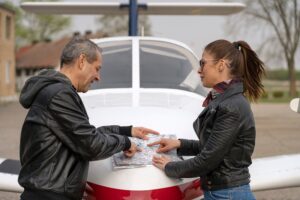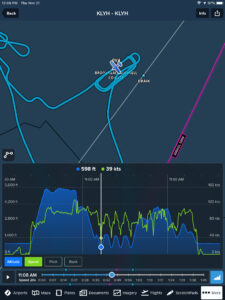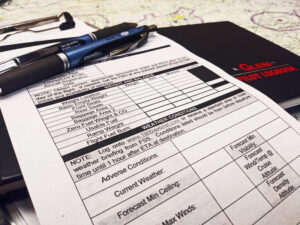 Two very important, yet often overlooked, aspects of flight training are the pre- and post-flight briefings. These briefings are frequently rushed (or skipped entirely!) because many do not realize the immense benefit they can offer. Between their anxiousness to get in the air and the sheer amount of they have yet to learn, new students can become inundated with information, which adversely affects flight lessons. A proper pre- and post-flight briefing allows students to focus on the task at hand and instructors to tailor the learning experience to the individual.
Two very important, yet often overlooked, aspects of flight training are the pre- and post-flight briefings. These briefings are frequently rushed (or skipped entirely!) because many do not realize the immense benefit they can offer. Between their anxiousness to get in the air and the sheer amount of they have yet to learn, new students can become inundated with information, which adversely affects flight lessons. A proper pre- and post-flight briefing allows students to focus on the task at hand and instructors to tailor the learning experience to the individual.
Flight Instructors: Here is your guide for conducting thorough pre- and post-flight briefings.
There are three basic guidelines that will make your briefings effective:
- Schedule time for the briefing. Make sure to schedule at least 30 minutes for each briefing. The actual time may be shorter or longer, but it is important you have enough time set aside so you do not feel pressured to rush.
- Let your student lead. To the greatest extent possible, briefings should be led by the student while the instructor asks guiding questions. During the early stages of primary training, the instructor will need to play a much larger role in conducting the briefing. As students progress, they should become more self-sufficient at briefing and debriefing themselves. Note: This assumes you’ve done your job by helping your students know what to expect for the lesson objectives and completion standards.
- Be prepared. Students need to have already reviewed the syllabus for the day’s lesson, weather, weight and balance, performance, etc. before meeting for the flight. It can be very helpful to use a standard pre-flight form to consolidate information that will need to be briefed. Instructors should take good notes during the flight and be familiar with the applicable Airman Certification Standards (ACS) so you’re able to properly gauge your students’ performance.
Help your students know what to expect for the lesson objectives and completion standards.
Preflight Briefing
Before every flight, students and instructors should discuss the following items:
Weather
The student should brief the instructor on the current and forecast weather conditions during the planned flight time. This should be much more in depth than “the weather looks good.” Every pre-flight briefing should include a review of any active SIGMETs, AIRMETs, or outlooks, the current METAR, the TAF forecast, and local radar returns. Prior to a cross country flight, a standard weather briefing should be obtained.
Weight and Balance
Prior to every flight, students should calculate the ramp weight, takeoff weight, landing weight, and center of gravity based on the required loading for the flight and verify that the results are within the aircraft’s limits. Using a spreadsheet or other tool can make these calculations much faster. However, instructors need to first ensure students are not over-relying on a device and are able to determine weight and balance themselves, and understand the effects of various loading configurations.
Performance
Students should also calculate the aircraft’s performance based on the current loading and weather conditions. Performance calculations should include determining the required runway length for takeoff and landing and the minimum required fuel (including ground operations and reserve). Then, review the airports of intended landing and make sure sufficient runway is available. Instructors, when discussing performance calculations with students, make sure you stress personal minimums and safety margins. Remember, just because the calculations say your aircraft has enough runway does not mean that you should necessarily try to takeoff!
NOTAMs and Risk Management
Review NOTAMs thoroughly before your flight especially noting any flight restrictions or TFRs. Also discuss any other hazards or factors that could increase risk on this flight. This could include things such as night operations, IMC, high winds, unfamiliar airports, recent experience, etc. Remember the I’M SAFE checklist.
I’M SAFE
Both the student and instructor should also run through the I’M SAFE checklist to ensure they are physically ready for the flight.
- Illness. Are you sick or dealing with any type of illness that will impair the safety of the flight?
- Medication. Are you taking any medication that is prohibited by the FAA or which will influence the safety of the flight?
- Stress. Are you under any psychological pressure from the job? Worried about financial matters, health problems, or family discord?
- Alcohol. How long has it been since you last consumed alcohol? Does this meet the FAA’s requirements? Are you still under the effects of alcohol in any way?
- Fatigue. Are you adequately rested? How long did you sleep the night before?
- Emotion/Eating. Are you emotionally upset? Have you had enough to eat prior to the flight? Are you hydrated? Will you need any food or water during the flight?
PIC Authority
The flight instructor should brief the student on who will be acting as PIC and has the final authority over the flight should an emergency situation occur. If this will change throughout the flight, brief who will be PIC and who will be at the controls during each phase. During training with a student who is not yet a private pilot, this is straightforward–the instructor is PIC. However, it can become vague who should be in charge when working towards advanced ratings with already certificated pilots or when working with someone for currency or a flight review, so discuss this during your pre-flight briefing and make sure you are specific.
Personal Documents
Both the flight instructor and student should verify that they have all required personal documents in their possession. This includes pilot certificates (and flight instructor certificate for the CFI), medical, and government-issued photo IDs. If a student or sport pilot is flying solo, ensure their logbook is carried along with the proper endorsements. Make sure that these documents are current and signed as appropriate.
Lesson Objectives
Finally, once you have discussed all of the above items and determined that circumstances will allow the safe completion of the flight, the next step is to brief the lesson objectives for the day’s flight. Students, be sure to review the syllabus beforehand. This briefing should not be your first exposure to what the flight will entail. It should be a review of the flights task’s and objectives. You should then also review the projected flight time, the order of tasks to be completed, and the completion standards.
Post-flight Debriefing
A post-flight debriefing should be completed immediately after the flight to review the student’s performance and plan for the next flight. It is important to conduct promptly so the details of the flight are fresh. Here’s what to discuss post-flight:
Maneuver Review
The main purpose of the post-flight briefing is to assess the student’s performance and note areas that need improvement. The student should start by describing how they thought they performed for each task or maneuver during the flight. Actual performance should be compared to desired performance in order to identify weak areas. The instructor should then offer insight into how the maneuvers can be improved and what specific actions the student should take to reach the desired performance. This requires students and instructors to both be thoroughly familiar with the ACS for each task, as this will eventually be what is required. Don’t expect students to meet the FAA standards from the very beginning, but the ACS should serve as a goal to strive toward and as a tool with which to measure performance.
 Single-Pilot Resource Management
Single-Pilot Resource Management
In addition to assessing the student’s performance on maneuvers, the student’s single pilot resource management should also be evaluated. This includes such items as aeronautical decision making and risk management. Consider the following:
- What obstacles presented themselves during the flight and how did the student handle them?
- Was the student thinking ahead of the airplane or were they constantly trying to catch up mentally?
Situational awareness and task management should also be reviewed. These are important skills that pilots need to develop, but they may not be obvious to students. Instructors, it is your job to teach how to handle the mental work of flying in addition to performing the physical maneuvers.
Next Lesson
Finally, the debriefing should end with a look ahead to the next lesson. The instructor should briefly review the content of the lesson and the meeting time should be planned. At this point, the instructor should also assign any necessary homework, such as reading material. Homework can also be used to help a student review weak areas from the previous flight or to prepare for the next flight.
Briefings are not a trivial exercise. Completing them allows students and instructors to begin and end lessons in a structured way that will help to maximize the learning experience. Instructors, if you don’t already, make sure to utilize these briefings on each flight to help your students progress. Students, if your instructor does not brief or debrief with you, ask them about it so you’ll know what to expect the next time you go out for a flight. You’ll immediately see what a difference it makes in both your performance, and confidence.
Written by Karl Winters, Gleim Aviation editor and instructor.


